Changing Management Practices and Theories in Organisational Behaviour
VerifiedAdded on 2024/01/17
|16
|5312
|221
AI Summary
This essay explores the changing management practices and theories in organisational behaviour since the early 20th century. It discusses the influences of organisational culture and structure on company performance. It also covers the understanding of personality, individual differences, and the relevance of different motivation theories. The subject is Organisational Behaviour.
Contribute Materials
Your contribution can guide someone’s learning journey. Share your
documents today.

Module Code:
Module Title:
Essay Title: ORGANISATIONAL BEHAVIOUR
Student Name:
Student ID:
Word Count:
Date:
Module Title:
Essay Title: ORGANISATIONAL BEHAVIOUR
Student Name:
Student ID:
Word Count:
Date:
Secure Best Marks with AI Grader
Need help grading? Try our AI Grader for instant feedback on your assignments.

Table of Contents
Introduction................................................................................................................................4
Section 1: Changing management practices...............................................................................4
Section 2: Theories, concepts, and evidence in organizational behaviour.................................6
Section 3: Understanding of Personality, individual differences, and the relevance of different
motivation theories.....................................................................................................................7
Section 4: Influences of Organisational Culture and Structure..................................................8
Section 5: Knowledge of managing groups and teams, workforce diversity, and globalisation
..................................................................................................................................................10
Section 6: Concept of learning organizations..........................................................................11
Conclusion................................................................................................................................12
Reference list............................................................................................................................13
2
Introduction................................................................................................................................4
Section 1: Changing management practices...............................................................................4
Section 2: Theories, concepts, and evidence in organizational behaviour.................................6
Section 3: Understanding of Personality, individual differences, and the relevance of different
motivation theories.....................................................................................................................7
Section 4: Influences of Organisational Culture and Structure..................................................8
Section 5: Knowledge of managing groups and teams, workforce diversity, and globalisation
..................................................................................................................................................10
Section 6: Concept of learning organizations..........................................................................11
Conclusion................................................................................................................................12
Reference list............................................................................................................................13
2
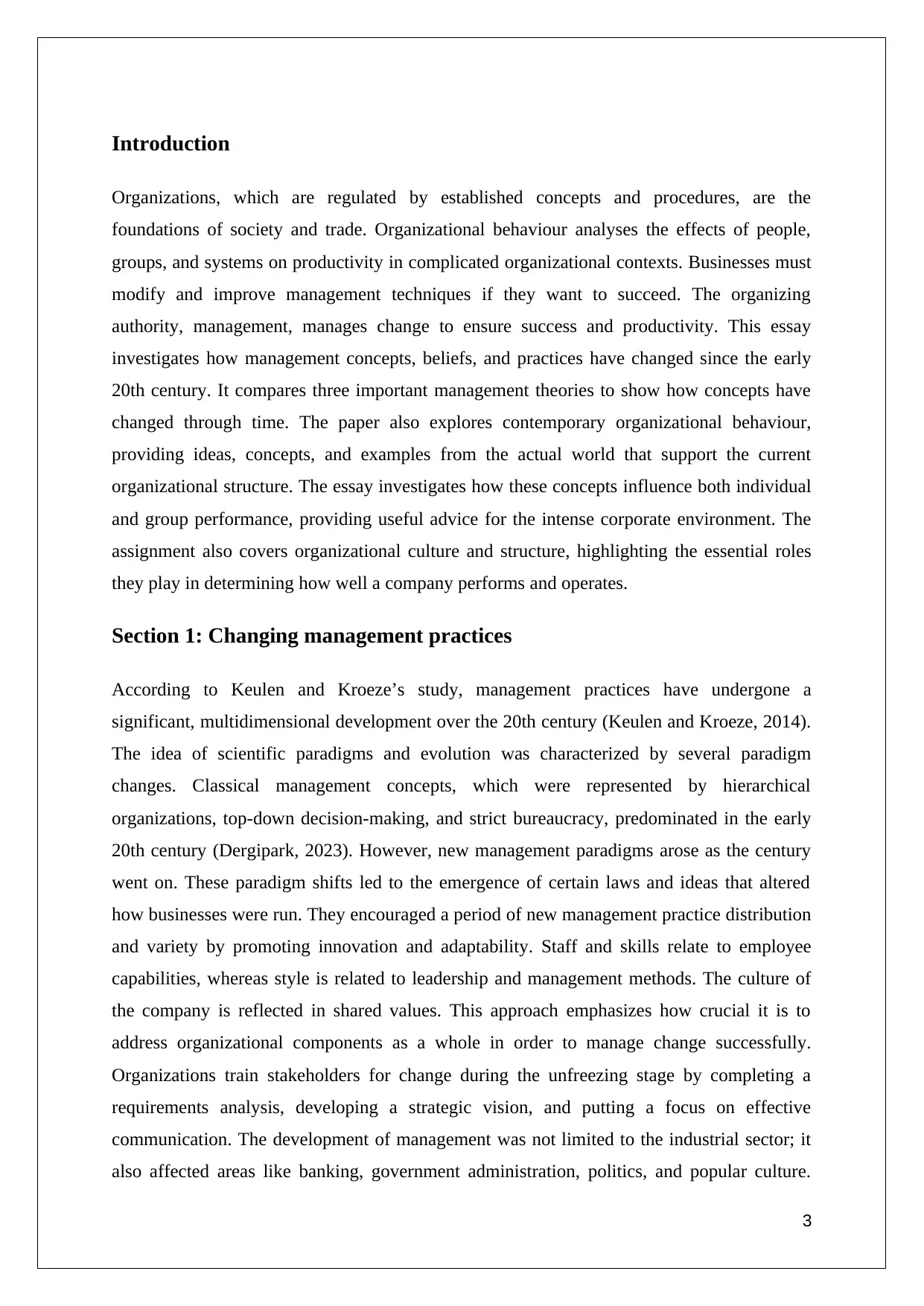
Introduction
Organizations, which are regulated by established concepts and procedures, are the
foundations of society and trade. Organizational behaviour analyses the effects of people,
groups, and systems on productivity in complicated organizational contexts. Businesses must
modify and improve management techniques if they want to succeed. The organizing
authority, management, manages change to ensure success and productivity. This essay
investigates how management concepts, beliefs, and practices have changed since the early
20th century. It compares three important management theories to show how concepts have
changed through time. The paper also explores contemporary organizational behaviour,
providing ideas, concepts, and examples from the actual world that support the current
organizational structure. The essay investigates how these concepts influence both individual
and group performance, providing useful advice for the intense corporate environment. The
assignment also covers organizational culture and structure, highlighting the essential roles
they play in determining how well a company performs and operates.
Section 1: Changing management practices
According to Keulen and Kroeze’s study, management practices have undergone a
significant, multidimensional development over the 20th century (Keulen and Kroeze, 2014).
The idea of scientific paradigms and evolution was characterized by several paradigm
changes. Classical management concepts, which were represented by hierarchical
organizations, top-down decision-making, and strict bureaucracy, predominated in the early
20th century (Dergipark, 2023). However, new management paradigms arose as the century
went on. These paradigm shifts led to the emergence of certain laws and ideas that altered
how businesses were run. They encouraged a period of new management practice distribution
and variety by promoting innovation and adaptability. Staff and skills relate to employee
capabilities, whereas style is related to leadership and management methods. The culture of
the company is reflected in shared values. This approach emphasizes how crucial it is to
address organizational components as a whole in order to manage change successfully.
Organizations train stakeholders for change during the unfreezing stage by completing a
requirements analysis, developing a strategic vision, and putting a focus on effective
communication. The development of management was not limited to the industrial sector; it
also affected areas like banking, government administration, politics, and popular culture.
3
Organizations, which are regulated by established concepts and procedures, are the
foundations of society and trade. Organizational behaviour analyses the effects of people,
groups, and systems on productivity in complicated organizational contexts. Businesses must
modify and improve management techniques if they want to succeed. The organizing
authority, management, manages change to ensure success and productivity. This essay
investigates how management concepts, beliefs, and practices have changed since the early
20th century. It compares three important management theories to show how concepts have
changed through time. The paper also explores contemporary organizational behaviour,
providing ideas, concepts, and examples from the actual world that support the current
organizational structure. The essay investigates how these concepts influence both individual
and group performance, providing useful advice for the intense corporate environment. The
assignment also covers organizational culture and structure, highlighting the essential roles
they play in determining how well a company performs and operates.
Section 1: Changing management practices
According to Keulen and Kroeze’s study, management practices have undergone a
significant, multidimensional development over the 20th century (Keulen and Kroeze, 2014).
The idea of scientific paradigms and evolution was characterized by several paradigm
changes. Classical management concepts, which were represented by hierarchical
organizations, top-down decision-making, and strict bureaucracy, predominated in the early
20th century (Dergipark, 2023). However, new management paradigms arose as the century
went on. These paradigm shifts led to the emergence of certain laws and ideas that altered
how businesses were run. They encouraged a period of new management practice distribution
and variety by promoting innovation and adaptability. Staff and skills relate to employee
capabilities, whereas style is related to leadership and management methods. The culture of
the company is reflected in shared values. This approach emphasizes how crucial it is to
address organizational components as a whole in order to manage change successfully.
Organizations train stakeholders for change during the unfreezing stage by completing a
requirements analysis, developing a strategic vision, and putting a focus on effective
communication. The development of management was not limited to the industrial sector; it
also affected areas like banking, government administration, politics, and popular culture.
3
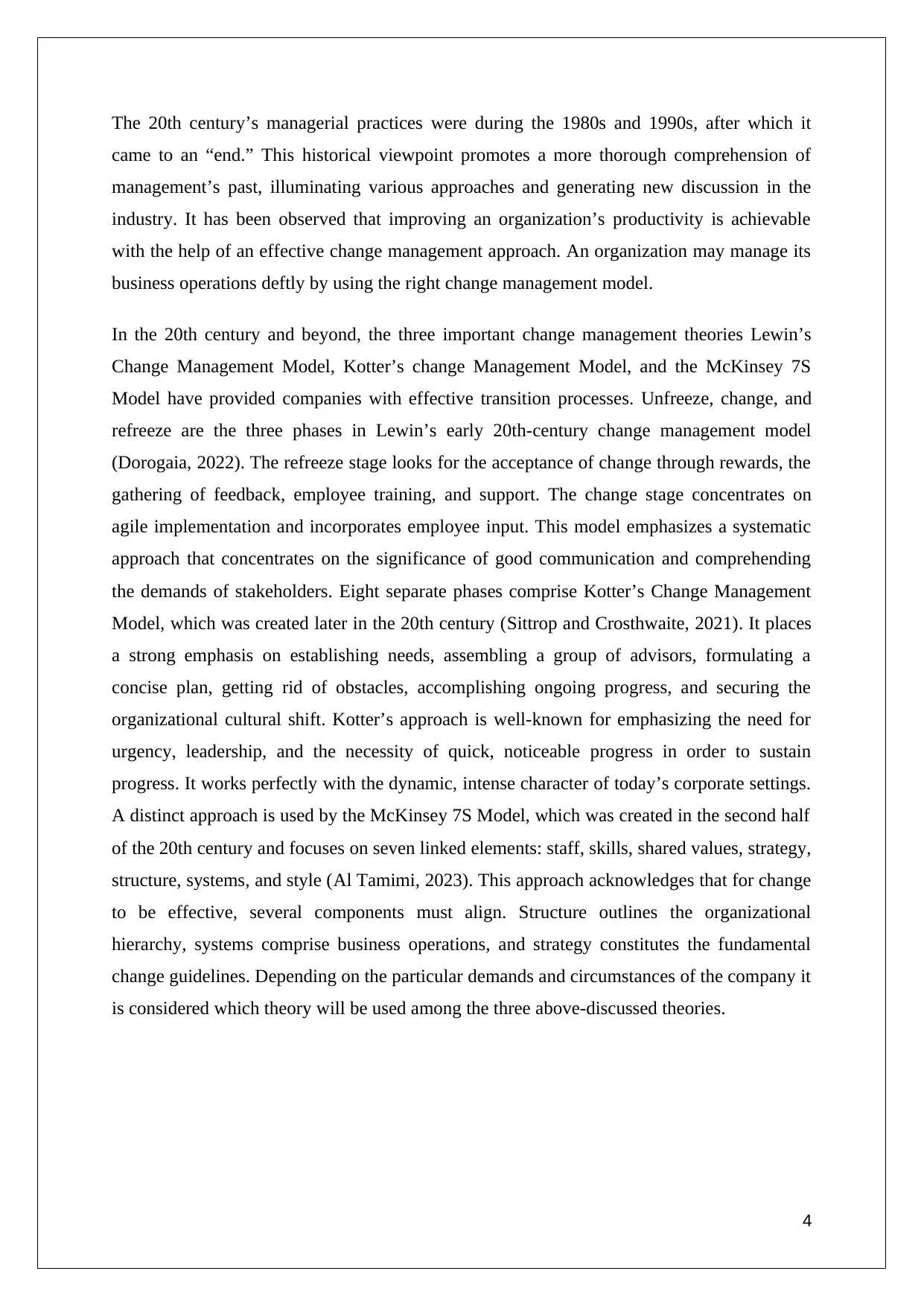
The 20th century’s managerial practices were during the 1980s and 1990s, after which it
came to an “end.” This historical viewpoint promotes a more thorough comprehension of
management’s past, illuminating various approaches and generating new discussion in the
industry. It has been observed that improving an organization’s productivity is achievable
with the help of an effective change management approach. An organization may manage its
business operations deftly by using the right change management model.
In the 20th century and beyond, the three important change management theories Lewin’s
Change Management Model, Kotter’s change Management Model, and the McKinsey 7S
Model have provided companies with effective transition processes. Unfreeze, change, and
refreeze are the three phases in Lewin’s early 20th-century change management model
(Dorogaia, 2022). The refreeze stage looks for the acceptance of change through rewards, the
gathering of feedback, employee training, and support. The change stage concentrates on
agile implementation and incorporates employee input. This model emphasizes a systematic
approach that concentrates on the significance of good communication and comprehending
the demands of stakeholders. Eight separate phases comprise Kotter’s Change Management
Model, which was created later in the 20th century (Sittrop and Crosthwaite, 2021). It places
a strong emphasis on establishing needs, assembling a group of advisors, formulating a
concise plan, getting rid of obstacles, accomplishing ongoing progress, and securing the
organizational cultural shift. Kotter’s approach is well-known for emphasizing the need for
urgency, leadership, and the necessity of quick, noticeable progress in order to sustain
progress. It works perfectly with the dynamic, intense character of today’s corporate settings.
A distinct approach is used by the McKinsey 7S Model, which was created in the second half
of the 20th century and focuses on seven linked elements: staff, skills, shared values, strategy,
structure, systems, and style (Al Tamimi, 2023). This approach acknowledges that for change
to be effective, several components must align. Structure outlines the organizational
hierarchy, systems comprise business operations, and strategy constitutes the fundamental
change guidelines. Depending on the particular demands and circumstances of the company it
is considered which theory will be used among the three above-discussed theories.
4
came to an “end.” This historical viewpoint promotes a more thorough comprehension of
management’s past, illuminating various approaches and generating new discussion in the
industry. It has been observed that improving an organization’s productivity is achievable
with the help of an effective change management approach. An organization may manage its
business operations deftly by using the right change management model.
In the 20th century and beyond, the three important change management theories Lewin’s
Change Management Model, Kotter’s change Management Model, and the McKinsey 7S
Model have provided companies with effective transition processes. Unfreeze, change, and
refreeze are the three phases in Lewin’s early 20th-century change management model
(Dorogaia, 2022). The refreeze stage looks for the acceptance of change through rewards, the
gathering of feedback, employee training, and support. The change stage concentrates on
agile implementation and incorporates employee input. This model emphasizes a systematic
approach that concentrates on the significance of good communication and comprehending
the demands of stakeholders. Eight separate phases comprise Kotter’s Change Management
Model, which was created later in the 20th century (Sittrop and Crosthwaite, 2021). It places
a strong emphasis on establishing needs, assembling a group of advisors, formulating a
concise plan, getting rid of obstacles, accomplishing ongoing progress, and securing the
organizational cultural shift. Kotter’s approach is well-known for emphasizing the need for
urgency, leadership, and the necessity of quick, noticeable progress in order to sustain
progress. It works perfectly with the dynamic, intense character of today’s corporate settings.
A distinct approach is used by the McKinsey 7S Model, which was created in the second half
of the 20th century and focuses on seven linked elements: staff, skills, shared values, strategy,
structure, systems, and style (Al Tamimi, 2023). This approach acknowledges that for change
to be effective, several components must align. Structure outlines the organizational
hierarchy, systems comprise business operations, and strategy constitutes the fundamental
change guidelines. Depending on the particular demands and circumstances of the company it
is considered which theory will be used among the three above-discussed theories.
4
Secure Best Marks with AI Grader
Need help grading? Try our AI Grader for instant feedback on your assignments.
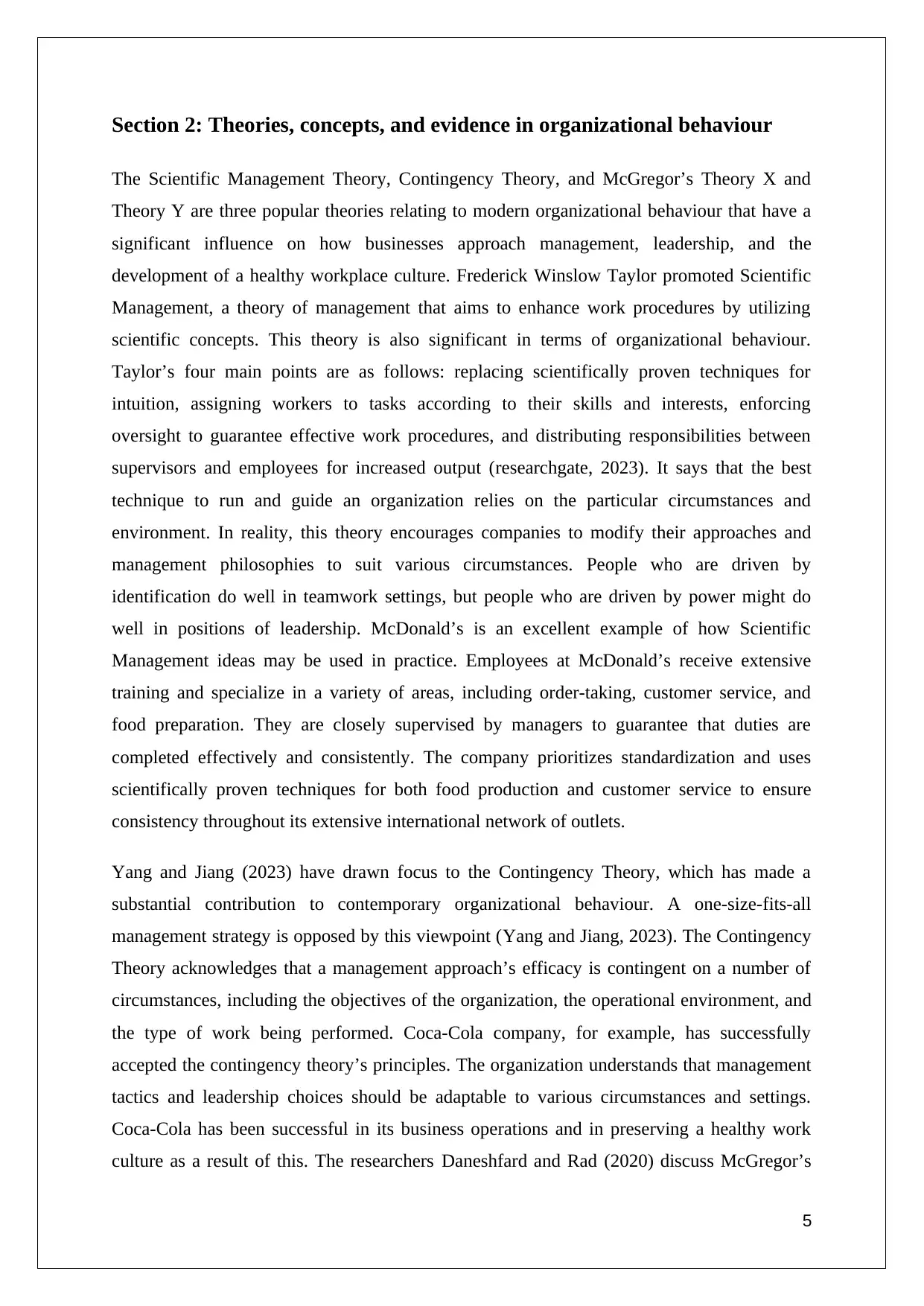
Section 2: Theories, concepts, and evidence in organizational behaviour
The Scientific Management Theory, Contingency Theory, and McGregor’s Theory X and
Theory Y are three popular theories relating to modern organizational behaviour that have a
significant influence on how businesses approach management, leadership, and the
development of a healthy workplace culture. Frederick Winslow Taylor promoted Scientific
Management, a theory of management that aims to enhance work procedures by utilizing
scientific concepts. This theory is also significant in terms of organizational behaviour.
Taylor’s four main points are as follows: replacing scientifically proven techniques for
intuition, assigning workers to tasks according to their skills and interests, enforcing
oversight to guarantee effective work procedures, and distributing responsibilities between
supervisors and employees for increased output (researchgate, 2023). It says that the best
technique to run and guide an organization relies on the particular circumstances and
environment. In reality, this theory encourages companies to modify their approaches and
management philosophies to suit various circumstances. People who are driven by
identification do well in teamwork settings, but people who are driven by power might do
well in positions of leadership. McDonald’s is an excellent example of how Scientific
Management ideas may be used in practice. Employees at McDonald’s receive extensive
training and specialize in a variety of areas, including order-taking, customer service, and
food preparation. They are closely supervised by managers to guarantee that duties are
completed effectively and consistently. The company prioritizes standardization and uses
scientifically proven techniques for both food production and customer service to ensure
consistency throughout its extensive international network of outlets.
Yang and Jiang (2023) have drawn focus to the Contingency Theory, which has made a
substantial contribution to contemporary organizational behaviour. A one-size-fits-all
management strategy is opposed by this viewpoint (Yang and Jiang, 2023). The Contingency
Theory acknowledges that a management approach’s efficacy is contingent on a number of
circumstances, including the objectives of the organization, the operational environment, and
the type of work being performed. Coca-Cola company, for example, has successfully
accepted the contingency theory’s principles. The organization understands that management
tactics and leadership choices should be adaptable to various circumstances and settings.
Coca-Cola has been successful in its business operations and in preserving a healthy work
culture as a result of this. The researchers Daneshfard and Rad (2020) discuss McGregor’s
5
The Scientific Management Theory, Contingency Theory, and McGregor’s Theory X and
Theory Y are three popular theories relating to modern organizational behaviour that have a
significant influence on how businesses approach management, leadership, and the
development of a healthy workplace culture. Frederick Winslow Taylor promoted Scientific
Management, a theory of management that aims to enhance work procedures by utilizing
scientific concepts. This theory is also significant in terms of organizational behaviour.
Taylor’s four main points are as follows: replacing scientifically proven techniques for
intuition, assigning workers to tasks according to their skills and interests, enforcing
oversight to guarantee effective work procedures, and distributing responsibilities between
supervisors and employees for increased output (researchgate, 2023). It says that the best
technique to run and guide an organization relies on the particular circumstances and
environment. In reality, this theory encourages companies to modify their approaches and
management philosophies to suit various circumstances. People who are driven by
identification do well in teamwork settings, but people who are driven by power might do
well in positions of leadership. McDonald’s is an excellent example of how Scientific
Management ideas may be used in practice. Employees at McDonald’s receive extensive
training and specialize in a variety of areas, including order-taking, customer service, and
food preparation. They are closely supervised by managers to guarantee that duties are
completed effectively and consistently. The company prioritizes standardization and uses
scientifically proven techniques for both food production and customer service to ensure
consistency throughout its extensive international network of outlets.
Yang and Jiang (2023) have drawn focus to the Contingency Theory, which has made a
substantial contribution to contemporary organizational behaviour. A one-size-fits-all
management strategy is opposed by this viewpoint (Yang and Jiang, 2023). The Contingency
Theory acknowledges that a management approach’s efficacy is contingent on a number of
circumstances, including the objectives of the organization, the operational environment, and
the type of work being performed. Coca-Cola company, for example, has successfully
accepted the contingency theory’s principles. The organization understands that management
tactics and leadership choices should be adaptable to various circumstances and settings.
Coca-Cola has been successful in its business operations and in preserving a healthy work
culture as a result of this. The researchers Daneshfard and Rad (2020) discuss McGregor’s
5
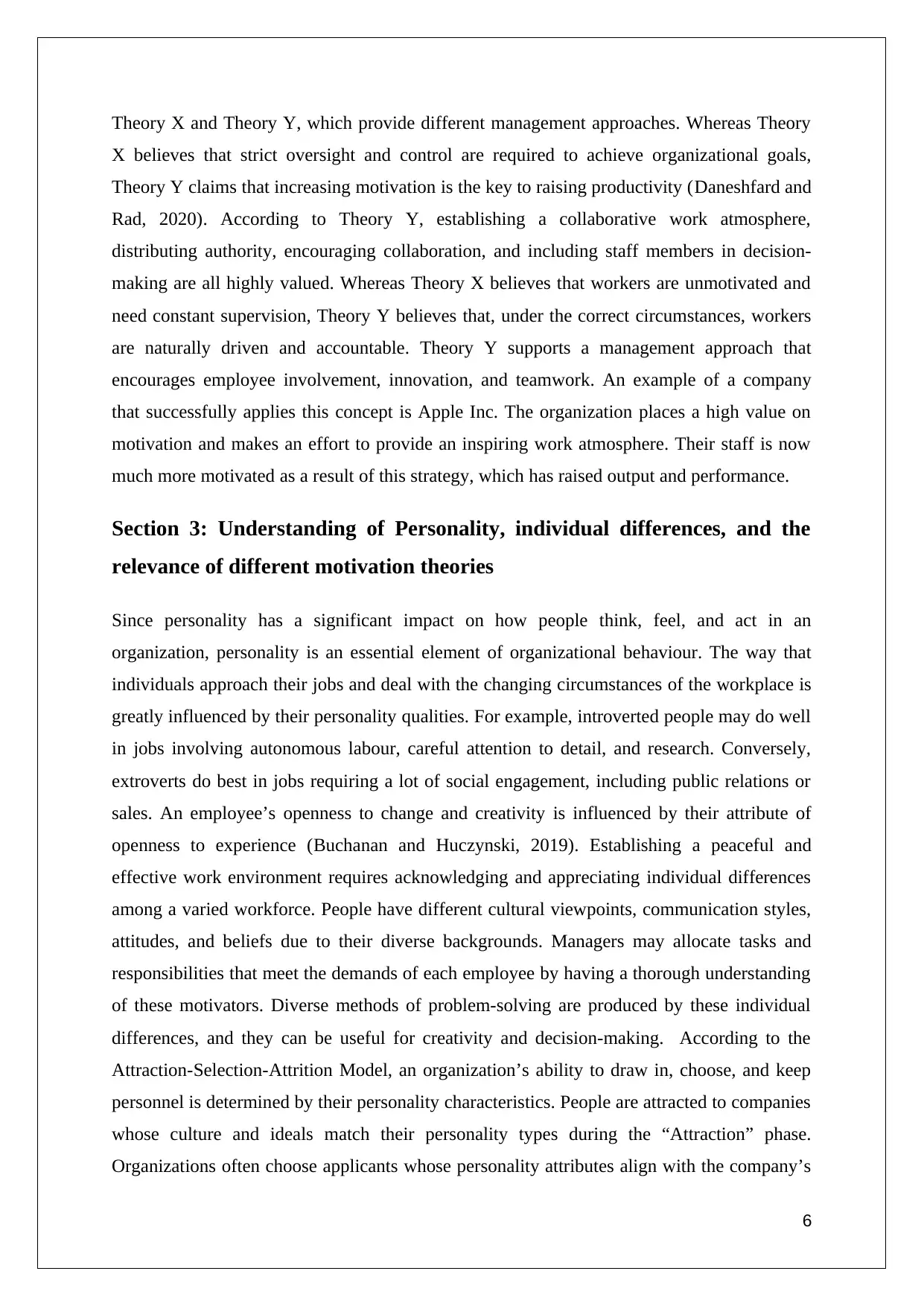
Theory X and Theory Y, which provide different management approaches. Whereas Theory
X believes that strict oversight and control are required to achieve organizational goals,
Theory Y claims that increasing motivation is the key to raising productivity (Daneshfard and
Rad, 2020). According to Theory Y, establishing a collaborative work atmosphere,
distributing authority, encouraging collaboration, and including staff members in decision-
making are all highly valued. Whereas Theory X believes that workers are unmotivated and
need constant supervision, Theory Y believes that, under the correct circumstances, workers
are naturally driven and accountable. Theory Y supports a management approach that
encourages employee involvement, innovation, and teamwork. An example of a company
that successfully applies this concept is Apple Inc. The organization places a high value on
motivation and makes an effort to provide an inspiring work atmosphere. Their staff is now
much more motivated as a result of this strategy, which has raised output and performance.
Section 3: Understanding of Personality, individual differences, and the
relevance of different motivation theories
Since personality has a significant impact on how people think, feel, and act in an
organization, personality is an essential element of organizational behaviour. The way that
individuals approach their jobs and deal with the changing circumstances of the workplace is
greatly influenced by their personality qualities. For example, introverted people may do well
in jobs involving autonomous labour, careful attention to detail, and research. Conversely,
extroverts do best in jobs requiring a lot of social engagement, including public relations or
sales. An employee’s openness to change and creativity is influenced by their attribute of
openness to experience (Buchanan and Huczynski, 2019). Establishing a peaceful and
effective work environment requires acknowledging and appreciating individual differences
among a varied workforce. People have different cultural viewpoints, communication styles,
attitudes, and beliefs due to their diverse backgrounds. Managers may allocate tasks and
responsibilities that meet the demands of each employee by having a thorough understanding
of these motivators. Diverse methods of problem-solving are produced by these individual
differences, and they can be useful for creativity and decision-making. According to the
Attraction-Selection-Attrition Model, an organization’s ability to draw in, choose, and keep
personnel is determined by their personality characteristics. People are attracted to companies
whose culture and ideals match their personality types during the “Attraction” phase.
Organizations often choose applicants whose personality attributes align with the company’s
6
X believes that strict oversight and control are required to achieve organizational goals,
Theory Y claims that increasing motivation is the key to raising productivity (Daneshfard and
Rad, 2020). According to Theory Y, establishing a collaborative work atmosphere,
distributing authority, encouraging collaboration, and including staff members in decision-
making are all highly valued. Whereas Theory X believes that workers are unmotivated and
need constant supervision, Theory Y believes that, under the correct circumstances, workers
are naturally driven and accountable. Theory Y supports a management approach that
encourages employee involvement, innovation, and teamwork. An example of a company
that successfully applies this concept is Apple Inc. The organization places a high value on
motivation and makes an effort to provide an inspiring work atmosphere. Their staff is now
much more motivated as a result of this strategy, which has raised output and performance.
Section 3: Understanding of Personality, individual differences, and the
relevance of different motivation theories
Since personality has a significant impact on how people think, feel, and act in an
organization, personality is an essential element of organizational behaviour. The way that
individuals approach their jobs and deal with the changing circumstances of the workplace is
greatly influenced by their personality qualities. For example, introverted people may do well
in jobs involving autonomous labour, careful attention to detail, and research. Conversely,
extroverts do best in jobs requiring a lot of social engagement, including public relations or
sales. An employee’s openness to change and creativity is influenced by their attribute of
openness to experience (Buchanan and Huczynski, 2019). Establishing a peaceful and
effective work environment requires acknowledging and appreciating individual differences
among a varied workforce. People have different cultural viewpoints, communication styles,
attitudes, and beliefs due to their diverse backgrounds. Managers may allocate tasks and
responsibilities that meet the demands of each employee by having a thorough understanding
of these motivators. Diverse methods of problem-solving are produced by these individual
differences, and they can be useful for creativity and decision-making. According to the
Attraction-Selection-Attrition Model, an organization’s ability to draw in, choose, and keep
personnel is determined by their personality characteristics. People are attracted to companies
whose culture and ideals match their personality types during the “Attraction” phase.
Organizations often choose applicants whose personality attributes align with the company’s
6
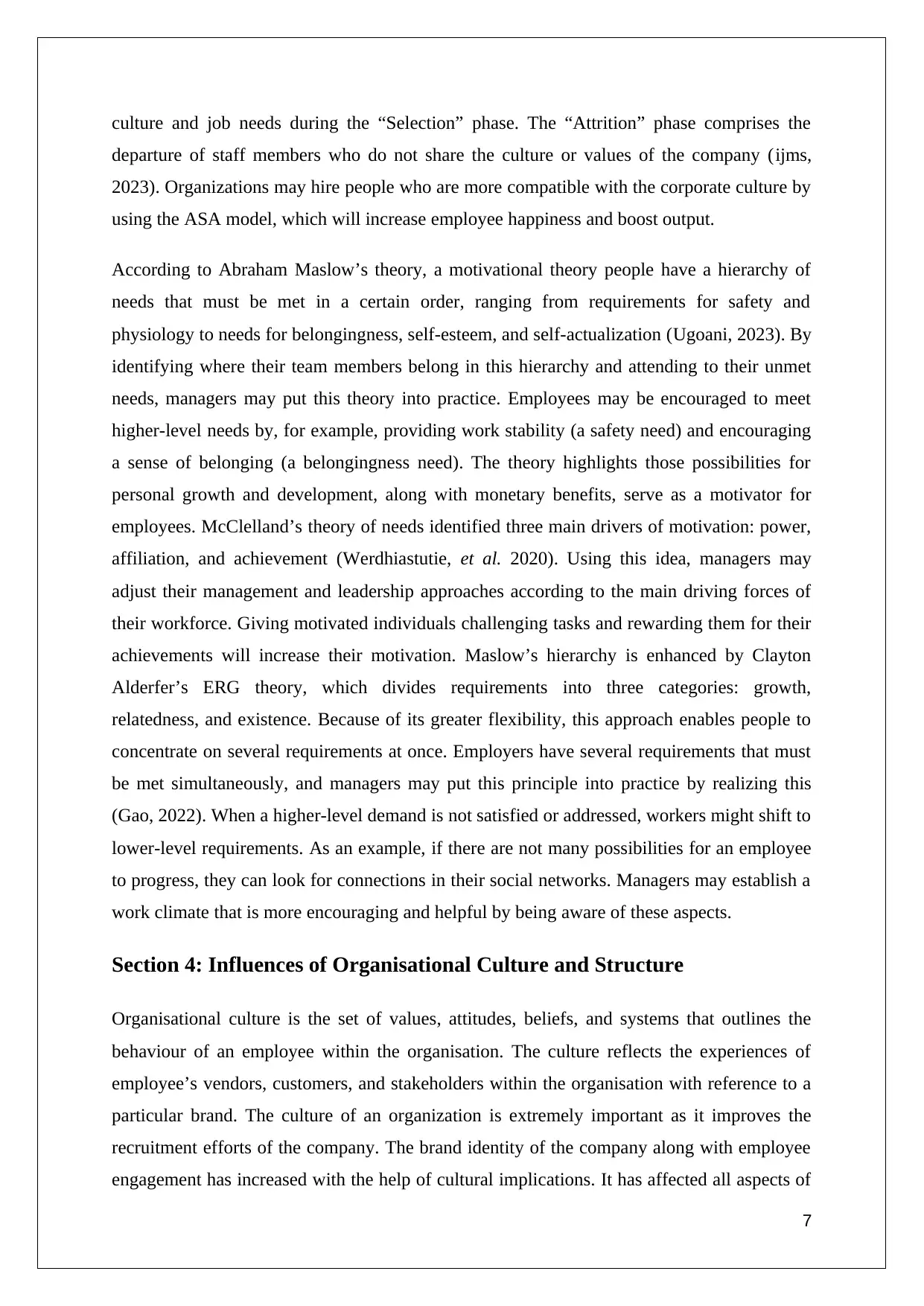
culture and job needs during the “Selection” phase. The “Attrition” phase comprises the
departure of staff members who do not share the culture or values of the company (ijms,
2023). Organizations may hire people who are more compatible with the corporate culture by
using the ASA model, which will increase employee happiness and boost output.
According to Abraham Maslow’s theory, a motivational theory people have a hierarchy of
needs that must be met in a certain order, ranging from requirements for safety and
physiology to needs for belongingness, self-esteem, and self-actualization (Ugoani, 2023). By
identifying where their team members belong in this hierarchy and attending to their unmet
needs, managers may put this theory into practice. Employees may be encouraged to meet
higher-level needs by, for example, providing work stability (a safety need) and encouraging
a sense of belonging (a belongingness need). The theory highlights those possibilities for
personal growth and development, along with monetary benefits, serve as a motivator for
employees. McClelland’s theory of needs identified three main drivers of motivation: power,
affiliation, and achievement (Werdhiastutie, et al. 2020). Using this idea, managers may
adjust their management and leadership approaches according to the main driving forces of
their workforce. Giving motivated individuals challenging tasks and rewarding them for their
achievements will increase their motivation. Maslow’s hierarchy is enhanced by Clayton
Alderfer’s ERG theory, which divides requirements into three categories: growth,
relatedness, and existence. Because of its greater flexibility, this approach enables people to
concentrate on several requirements at once. Employers have several requirements that must
be met simultaneously, and managers may put this principle into practice by realizing this
(Gao, 2022). When a higher-level demand is not satisfied or addressed, workers might shift to
lower-level requirements. As an example, if there are not many possibilities for an employee
to progress, they can look for connections in their social networks. Managers may establish a
work climate that is more encouraging and helpful by being aware of these aspects.
Section 4: Influences of Organisational Culture and Structure
Organisational culture is the set of values, attitudes, beliefs, and systems that outlines the
behaviour of an employee within the organisation. The culture reflects the experiences of
employee’s vendors, customers, and stakeholders within the organisation with reference to a
particular brand. The culture of an organization is extremely important as it improves the
recruitment efforts of the company. The brand identity of the company along with employee
engagement has increased with the help of cultural implications. It has affected all aspects of
7
departure of staff members who do not share the culture or values of the company (ijms,
2023). Organizations may hire people who are more compatible with the corporate culture by
using the ASA model, which will increase employee happiness and boost output.
According to Abraham Maslow’s theory, a motivational theory people have a hierarchy of
needs that must be met in a certain order, ranging from requirements for safety and
physiology to needs for belongingness, self-esteem, and self-actualization (Ugoani, 2023). By
identifying where their team members belong in this hierarchy and attending to their unmet
needs, managers may put this theory into practice. Employees may be encouraged to meet
higher-level needs by, for example, providing work stability (a safety need) and encouraging
a sense of belonging (a belongingness need). The theory highlights those possibilities for
personal growth and development, along with monetary benefits, serve as a motivator for
employees. McClelland’s theory of needs identified three main drivers of motivation: power,
affiliation, and achievement (Werdhiastutie, et al. 2020). Using this idea, managers may
adjust their management and leadership approaches according to the main driving forces of
their workforce. Giving motivated individuals challenging tasks and rewarding them for their
achievements will increase their motivation. Maslow’s hierarchy is enhanced by Clayton
Alderfer’s ERG theory, which divides requirements into three categories: growth,
relatedness, and existence. Because of its greater flexibility, this approach enables people to
concentrate on several requirements at once. Employers have several requirements that must
be met simultaneously, and managers may put this principle into practice by realizing this
(Gao, 2022). When a higher-level demand is not satisfied or addressed, workers might shift to
lower-level requirements. As an example, if there are not many possibilities for an employee
to progress, they can look for connections in their social networks. Managers may establish a
work climate that is more encouraging and helpful by being aware of these aspects.
Section 4: Influences of Organisational Culture and Structure
Organisational culture is the set of values, attitudes, beliefs, and systems that outlines the
behaviour of an employee within the organisation. The culture reflects the experiences of
employee’s vendors, customers, and stakeholders within the organisation with reference to a
particular brand. The culture of an organization is extremely important as it improves the
recruitment efforts of the company. The brand identity of the company along with employee
engagement has increased with the help of cultural implications. It has affected all aspects of
7
Paraphrase This Document
Need a fresh take? Get an instant paraphrase of this document with our AI Paraphraser
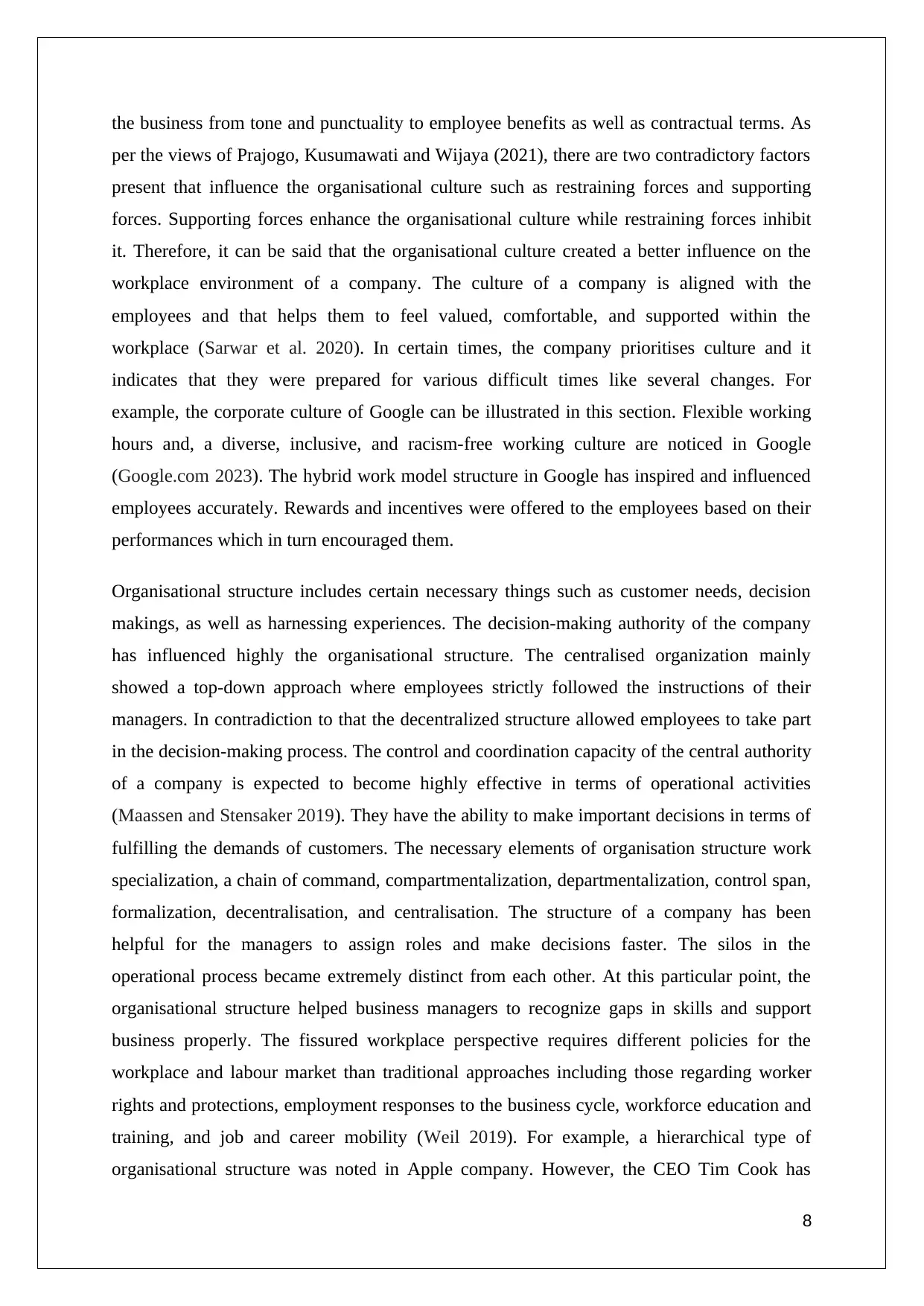
the business from tone and punctuality to employee benefits as well as contractual terms. As
per the views of Prajogo, Kusumawati and Wijaya (2021), there are two contradictory factors
present that influence the organisational culture such as restraining forces and supporting
forces. Supporting forces enhance the organisational culture while restraining forces inhibit
it. Therefore, it can be said that the organisational culture created a better influence on the
workplace environment of a company. The culture of a company is aligned with the
employees and that helps them to feel valued, comfortable, and supported within the
workplace (Sarwar et al. 2020). In certain times, the company prioritises culture and it
indicates that they were prepared for various difficult times like several changes. For
example, the corporate culture of Google can be illustrated in this section. Flexible working
hours and, a diverse, inclusive, and racism-free working culture are noticed in Google
(Google.com 2023). The hybrid work model structure in Google has inspired and influenced
employees accurately. Rewards and incentives were offered to the employees based on their
performances which in turn encouraged them.
Organisational structure includes certain necessary things such as customer needs, decision
makings, as well as harnessing experiences. The decision-making authority of the company
has influenced highly the organisational structure. The centralised organization mainly
showed a top-down approach where employees strictly followed the instructions of their
managers. In contradiction to that the decentralized structure allowed employees to take part
in the decision-making process. The control and coordination capacity of the central authority
of a company is expected to become highly effective in terms of operational activities
(Maassen and Stensaker 2019). They have the ability to make important decisions in terms of
fulfilling the demands of customers. The necessary elements of organisation structure work
specialization, a chain of command, compartmentalization, departmentalization, control span,
formalization, decentralisation, and centralisation. The structure of a company has been
helpful for the managers to assign roles and make decisions faster. The silos in the
operational process became extremely distinct from each other. At this particular point, the
organisational structure helped business managers to recognize gaps in skills and support
business properly. The fissured workplace perspective requires different policies for the
workplace and labour market than traditional approaches including those regarding worker
rights and protections, employment responses to the business cycle, workforce education and
training, and job and career mobility (Weil 2019). For example, a hierarchical type of
organisational structure was noted in Apple company. However, the CEO Tim Cook has
8
per the views of Prajogo, Kusumawati and Wijaya (2021), there are two contradictory factors
present that influence the organisational culture such as restraining forces and supporting
forces. Supporting forces enhance the organisational culture while restraining forces inhibit
it. Therefore, it can be said that the organisational culture created a better influence on the
workplace environment of a company. The culture of a company is aligned with the
employees and that helps them to feel valued, comfortable, and supported within the
workplace (Sarwar et al. 2020). In certain times, the company prioritises culture and it
indicates that they were prepared for various difficult times like several changes. For
example, the corporate culture of Google can be illustrated in this section. Flexible working
hours and, a diverse, inclusive, and racism-free working culture are noticed in Google
(Google.com 2023). The hybrid work model structure in Google has inspired and influenced
employees accurately. Rewards and incentives were offered to the employees based on their
performances which in turn encouraged them.
Organisational structure includes certain necessary things such as customer needs, decision
makings, as well as harnessing experiences. The decision-making authority of the company
has influenced highly the organisational structure. The centralised organization mainly
showed a top-down approach where employees strictly followed the instructions of their
managers. In contradiction to that the decentralized structure allowed employees to take part
in the decision-making process. The control and coordination capacity of the central authority
of a company is expected to become highly effective in terms of operational activities
(Maassen and Stensaker 2019). They have the ability to make important decisions in terms of
fulfilling the demands of customers. The necessary elements of organisation structure work
specialization, a chain of command, compartmentalization, departmentalization, control span,
formalization, decentralisation, and centralisation. The structure of a company has been
helpful for the managers to assign roles and make decisions faster. The silos in the
operational process became extremely distinct from each other. At this particular point, the
organisational structure helped business managers to recognize gaps in skills and support
business properly. The fissured workplace perspective requires different policies for the
workplace and labour market than traditional approaches including those regarding worker
rights and protections, employment responses to the business cycle, workforce education and
training, and job and career mobility (Weil 2019). For example, a hierarchical type of
organisational structure was noted in Apple company. However, the CEO Tim Cook has
8
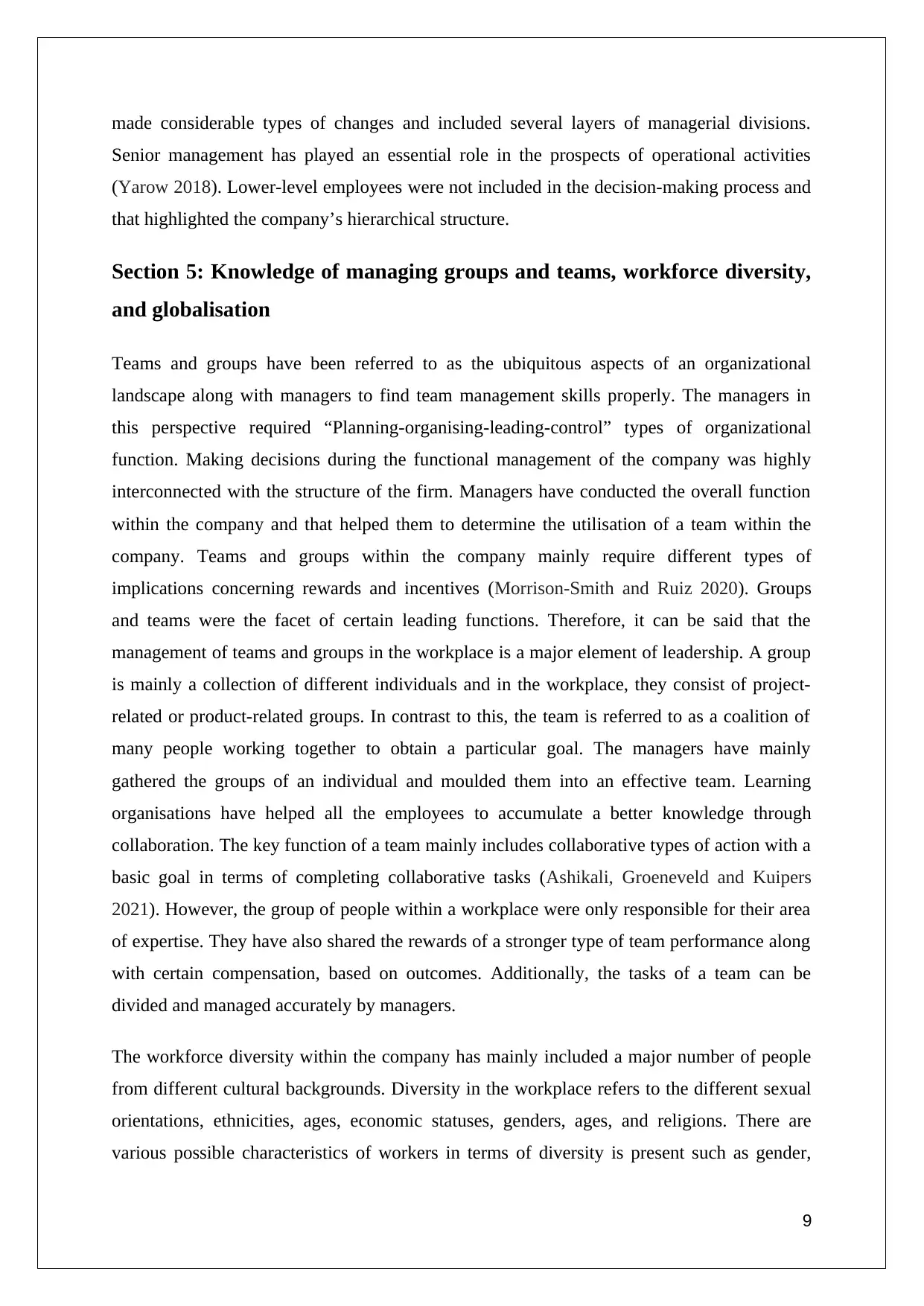
made considerable types of changes and included several layers of managerial divisions.
Senior management has played an essential role in the prospects of operational activities
(Yarow 2018). Lower-level employees were not included in the decision-making process and
that highlighted the company’s hierarchical structure.
Section 5: Knowledge of managing groups and teams, workforce diversity,
and globalisation
Teams and groups have been referred to as the ubiquitous aspects of an organizational
landscape along with managers to find team management skills properly. The managers in
this perspective required “Planning-organising-leading-control” types of organizational
function. Making decisions during the functional management of the company was highly
interconnected with the structure of the firm. Managers have conducted the overall function
within the company and that helped them to determine the utilisation of a team within the
company. Teams and groups within the company mainly require different types of
implications concerning rewards and incentives (Morrison-Smith and Ruiz 2020). Groups
and teams were the facet of certain leading functions. Therefore, it can be said that the
management of teams and groups in the workplace is a major element of leadership. A group
is mainly a collection of different individuals and in the workplace, they consist of project-
related or product-related groups. In contrast to this, the team is referred to as a coalition of
many people working together to obtain a particular goal. The managers have mainly
gathered the groups of an individual and moulded them into an effective team. Learning
organisations have helped all the employees to accumulate a better knowledge through
collaboration. The key function of a team mainly includes collaborative types of action with a
basic goal in terms of completing collaborative tasks (Ashikali, Groeneveld and Kuipers
2021). However, the group of people within a workplace were only responsible for their area
of expertise. They have also shared the rewards of a stronger type of team performance along
with certain compensation, based on outcomes. Additionally, the tasks of a team can be
divided and managed accurately by managers.
The workforce diversity within the company has mainly included a major number of people
from different cultural backgrounds. Diversity in the workplace refers to the different sexual
orientations, ethnicities, ages, economic statuses, genders, ages, and religions. There are
various possible characteristics of workers in terms of diversity is present such as gender,
9
Senior management has played an essential role in the prospects of operational activities
(Yarow 2018). Lower-level employees were not included in the decision-making process and
that highlighted the company’s hierarchical structure.
Section 5: Knowledge of managing groups and teams, workforce diversity,
and globalisation
Teams and groups have been referred to as the ubiquitous aspects of an organizational
landscape along with managers to find team management skills properly. The managers in
this perspective required “Planning-organising-leading-control” types of organizational
function. Making decisions during the functional management of the company was highly
interconnected with the structure of the firm. Managers have conducted the overall function
within the company and that helped them to determine the utilisation of a team within the
company. Teams and groups within the company mainly require different types of
implications concerning rewards and incentives (Morrison-Smith and Ruiz 2020). Groups
and teams were the facet of certain leading functions. Therefore, it can be said that the
management of teams and groups in the workplace is a major element of leadership. A group
is mainly a collection of different individuals and in the workplace, they consist of project-
related or product-related groups. In contrast to this, the team is referred to as a coalition of
many people working together to obtain a particular goal. The managers have mainly
gathered the groups of an individual and moulded them into an effective team. Learning
organisations have helped all the employees to accumulate a better knowledge through
collaboration. The key function of a team mainly includes collaborative types of action with a
basic goal in terms of completing collaborative tasks (Ashikali, Groeneveld and Kuipers
2021). However, the group of people within a workplace were only responsible for their area
of expertise. They have also shared the rewards of a stronger type of team performance along
with certain compensation, based on outcomes. Additionally, the tasks of a team can be
divided and managed accurately by managers.
The workforce diversity within the company has mainly included a major number of people
from different cultural backgrounds. Diversity in the workplace refers to the different sexual
orientations, ethnicities, ages, economic statuses, genders, ages, and religions. There are
various possible characteristics of workers in terms of diversity is present such as gender,
9
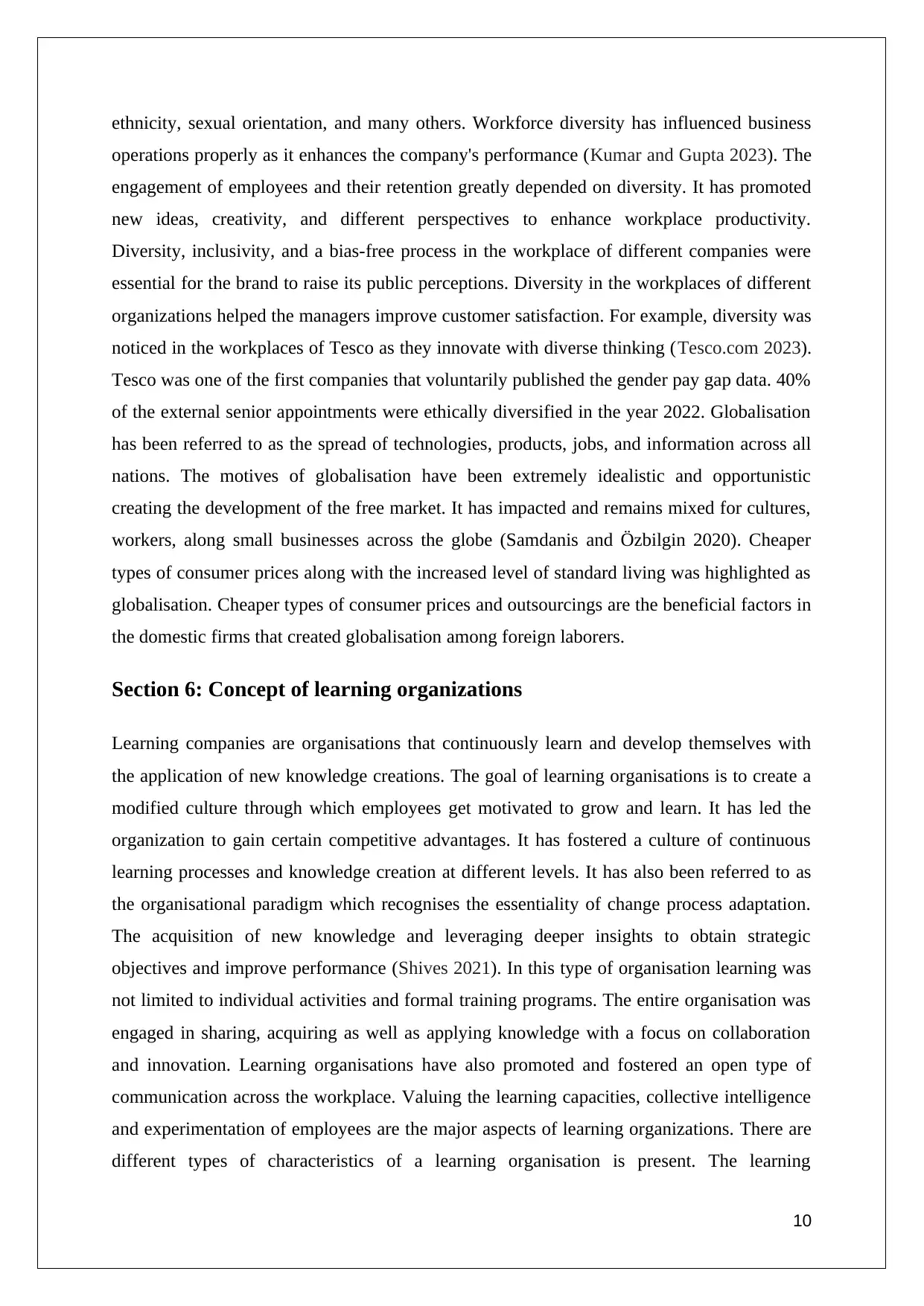
ethnicity, sexual orientation, and many others. Workforce diversity has influenced business
operations properly as it enhances the company's performance (Kumar and Gupta 2023). The
engagement of employees and their retention greatly depended on diversity. It has promoted
new ideas, creativity, and different perspectives to enhance workplace productivity.
Diversity, inclusivity, and a bias-free process in the workplace of different companies were
essential for the brand to raise its public perceptions. Diversity in the workplaces of different
organizations helped the managers improve customer satisfaction. For example, diversity was
noticed in the workplaces of Tesco as they innovate with diverse thinking (Tesco.com 2023).
Tesco was one of the first companies that voluntarily published the gender pay gap data. 40%
of the external senior appointments were ethically diversified in the year 2022. Globalisation
has been referred to as the spread of technologies, products, jobs, and information across all
nations. The motives of globalisation have been extremely idealistic and opportunistic
creating the development of the free market. It has impacted and remains mixed for cultures,
workers, along small businesses across the globe (Samdanis and Özbilgin 2020). Cheaper
types of consumer prices along with the increased level of standard living was highlighted as
globalisation. Cheaper types of consumer prices and outsourcings are the beneficial factors in
the domestic firms that created globalisation among foreign laborers.
Section 6: Concept of learning organizations
Learning companies are organisations that continuously learn and develop themselves with
the application of new knowledge creations. The goal of learning organisations is to create a
modified culture through which employees get motivated to grow and learn. It has led the
organization to gain certain competitive advantages. It has fostered a culture of continuous
learning processes and knowledge creation at different levels. It has also been referred to as
the organisational paradigm which recognises the essentiality of change process adaptation.
The acquisition of new knowledge and leveraging deeper insights to obtain strategic
objectives and improve performance (Shives 2021). In this type of organisation learning was
not limited to individual activities and formal training programs. The entire organisation was
engaged in sharing, acquiring as well as applying knowledge with a focus on collaboration
and innovation. Learning organisations have also promoted and fostered an open type of
communication across the workplace. Valuing the learning capacities, collective intelligence
and experimentation of employees are the major aspects of learning organizations. There are
different types of characteristics of a learning organisation is present. The learning
10
operations properly as it enhances the company's performance (Kumar and Gupta 2023). The
engagement of employees and their retention greatly depended on diversity. It has promoted
new ideas, creativity, and different perspectives to enhance workplace productivity.
Diversity, inclusivity, and a bias-free process in the workplace of different companies were
essential for the brand to raise its public perceptions. Diversity in the workplaces of different
organizations helped the managers improve customer satisfaction. For example, diversity was
noticed in the workplaces of Tesco as they innovate with diverse thinking (Tesco.com 2023).
Tesco was one of the first companies that voluntarily published the gender pay gap data. 40%
of the external senior appointments were ethically diversified in the year 2022. Globalisation
has been referred to as the spread of technologies, products, jobs, and information across all
nations. The motives of globalisation have been extremely idealistic and opportunistic
creating the development of the free market. It has impacted and remains mixed for cultures,
workers, along small businesses across the globe (Samdanis and Özbilgin 2020). Cheaper
types of consumer prices along with the increased level of standard living was highlighted as
globalisation. Cheaper types of consumer prices and outsourcings are the beneficial factors in
the domestic firms that created globalisation among foreign laborers.
Section 6: Concept of learning organizations
Learning companies are organisations that continuously learn and develop themselves with
the application of new knowledge creations. The goal of learning organisations is to create a
modified culture through which employees get motivated to grow and learn. It has led the
organization to gain certain competitive advantages. It has fostered a culture of continuous
learning processes and knowledge creation at different levels. It has also been referred to as
the organisational paradigm which recognises the essentiality of change process adaptation.
The acquisition of new knowledge and leveraging deeper insights to obtain strategic
objectives and improve performance (Shives 2021). In this type of organisation learning was
not limited to individual activities and formal training programs. The entire organisation was
engaged in sharing, acquiring as well as applying knowledge with a focus on collaboration
and innovation. Learning organisations have also promoted and fostered an open type of
communication across the workplace. Valuing the learning capacities, collective intelligence
and experimentation of employees are the major aspects of learning organizations. There are
different types of characteristics of a learning organisation is present. The learning
10
Secure Best Marks with AI Grader
Need help grading? Try our AI Grader for instant feedback on your assignments.
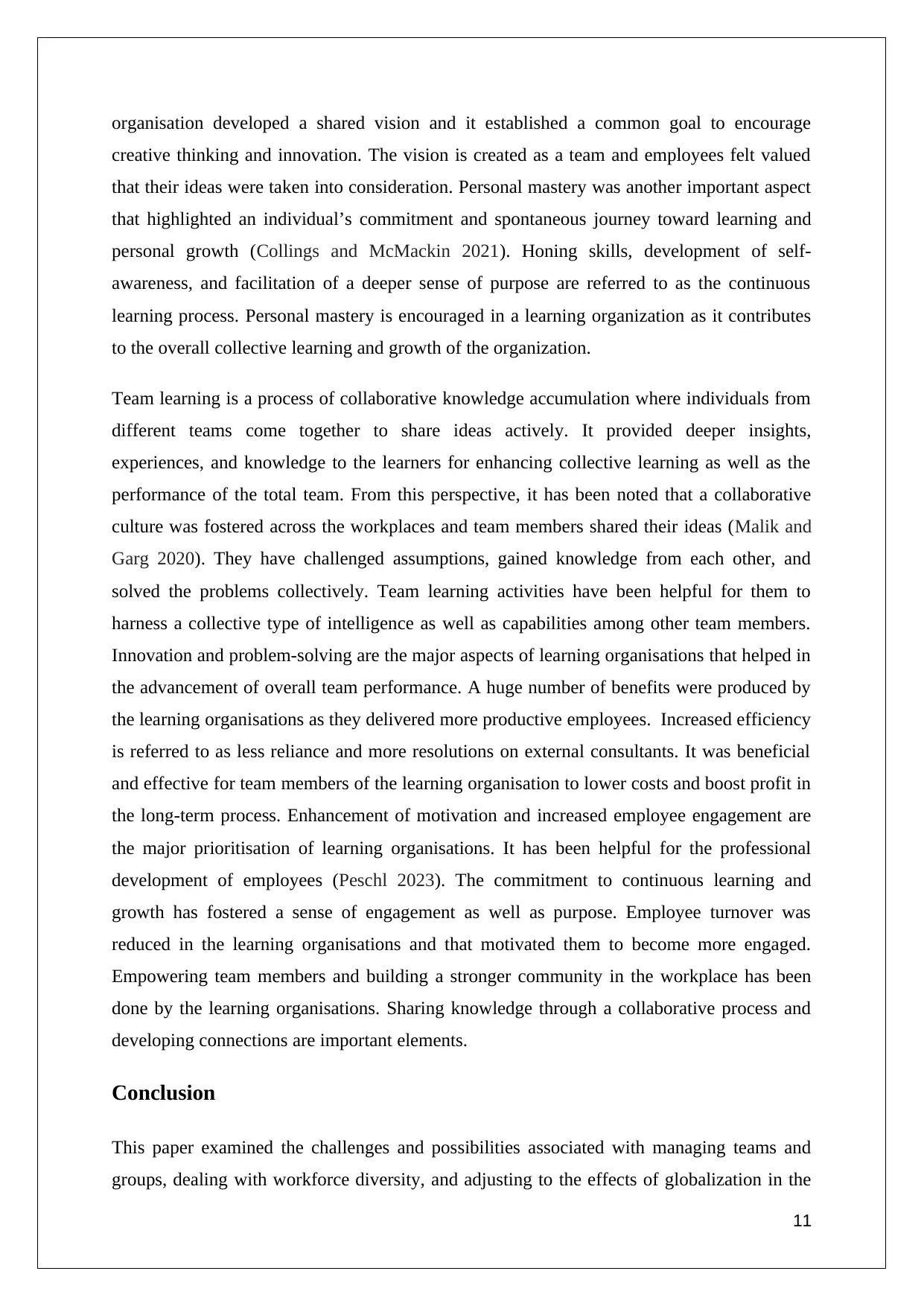
organisation developed a shared vision and it established a common goal to encourage
creative thinking and innovation. The vision is created as a team and employees felt valued
that their ideas were taken into consideration. Personal mastery was another important aspect
that highlighted an individual’s commitment and spontaneous journey toward learning and
personal growth (Collings and McMackin 2021). Honing skills, development of self-
awareness, and facilitation of a deeper sense of purpose are referred to as the continuous
learning process. Personal mastery is encouraged in a learning organization as it contributes
to the overall collective learning and growth of the organization.
Team learning is a process of collaborative knowledge accumulation where individuals from
different teams come together to share ideas actively. It provided deeper insights,
experiences, and knowledge to the learners for enhancing collective learning as well as the
performance of the total team. From this perspective, it has been noted that a collaborative
culture was fostered across the workplaces and team members shared their ideas (Malik and
Garg 2020). They have challenged assumptions, gained knowledge from each other, and
solved the problems collectively. Team learning activities have been helpful for them to
harness a collective type of intelligence as well as capabilities among other team members.
Innovation and problem-solving are the major aspects of learning organisations that helped in
the advancement of overall team performance. A huge number of benefits were produced by
the learning organisations as they delivered more productive employees. Increased efficiency
is referred to as less reliance and more resolutions on external consultants. It was beneficial
and effective for team members of the learning organisation to lower costs and boost profit in
the long-term process. Enhancement of motivation and increased employee engagement are
the major prioritisation of learning organisations. It has been helpful for the professional
development of employees (Peschl 2023). The commitment to continuous learning and
growth has fostered a sense of engagement as well as purpose. Employee turnover was
reduced in the learning organisations and that motivated them to become more engaged.
Empowering team members and building a stronger community in the workplace has been
done by the learning organisations. Sharing knowledge through a collaborative process and
developing connections are important elements.
Conclusion
This paper examined the challenges and possibilities associated with managing teams and
groups, dealing with workforce diversity, and adjusting to the effects of globalization in the
11
creative thinking and innovation. The vision is created as a team and employees felt valued
that their ideas were taken into consideration. Personal mastery was another important aspect
that highlighted an individual’s commitment and spontaneous journey toward learning and
personal growth (Collings and McMackin 2021). Honing skills, development of self-
awareness, and facilitation of a deeper sense of purpose are referred to as the continuous
learning process. Personal mastery is encouraged in a learning organization as it contributes
to the overall collective learning and growth of the organization.
Team learning is a process of collaborative knowledge accumulation where individuals from
different teams come together to share ideas actively. It provided deeper insights,
experiences, and knowledge to the learners for enhancing collective learning as well as the
performance of the total team. From this perspective, it has been noted that a collaborative
culture was fostered across the workplaces and team members shared their ideas (Malik and
Garg 2020). They have challenged assumptions, gained knowledge from each other, and
solved the problems collectively. Team learning activities have been helpful for them to
harness a collective type of intelligence as well as capabilities among other team members.
Innovation and problem-solving are the major aspects of learning organisations that helped in
the advancement of overall team performance. A huge number of benefits were produced by
the learning organisations as they delivered more productive employees. Increased efficiency
is referred to as less reliance and more resolutions on external consultants. It was beneficial
and effective for team members of the learning organisation to lower costs and boost profit in
the long-term process. Enhancement of motivation and increased employee engagement are
the major prioritisation of learning organisations. It has been helpful for the professional
development of employees (Peschl 2023). The commitment to continuous learning and
growth has fostered a sense of engagement as well as purpose. Employee turnover was
reduced in the learning organisations and that motivated them to become more engaged.
Empowering team members and building a stronger community in the workplace has been
done by the learning organisations. Sharing knowledge through a collaborative process and
developing connections are important elements.
Conclusion
This paper examined the challenges and possibilities associated with managing teams and
groups, dealing with workforce diversity, and adjusting to the effects of globalization in the
11
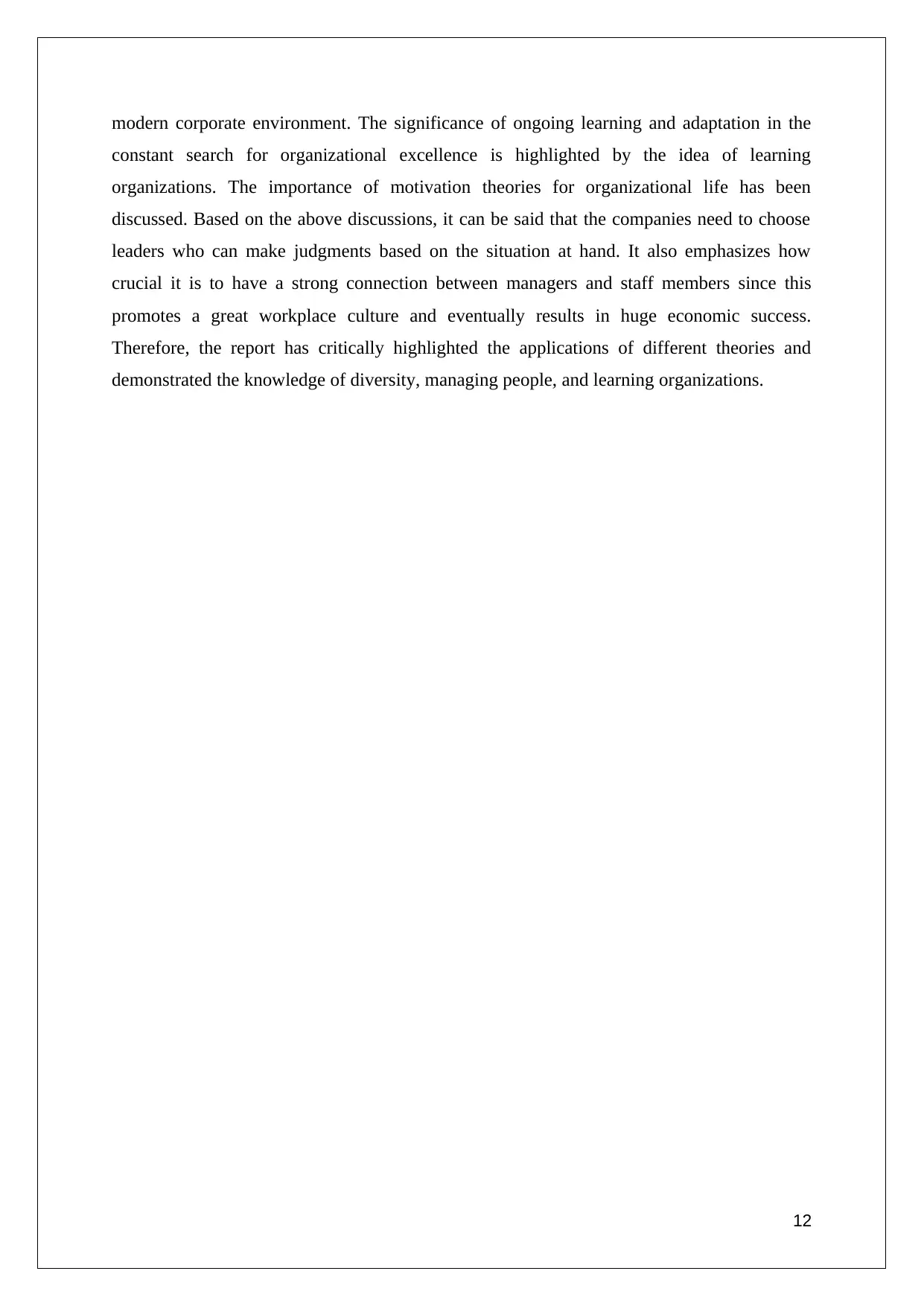
modern corporate environment. The significance of ongoing learning and adaptation in the
constant search for organizational excellence is highlighted by the idea of learning
organizations. The importance of motivation theories for organizational life has been
discussed. Based on the above discussions, it can be said that the companies need to choose
leaders who can make judgments based on the situation at hand. It also emphasizes how
crucial it is to have a strong connection between managers and staff members since this
promotes a great workplace culture and eventually results in huge economic success.
Therefore, the report has critically highlighted the applications of different theories and
demonstrated the knowledge of diversity, managing people, and learning organizations.
12
constant search for organizational excellence is highlighted by the idea of learning
organizations. The importance of motivation theories for organizational life has been
discussed. Based on the above discussions, it can be said that the companies need to choose
leaders who can make judgments based on the situation at hand. It also emphasizes how
crucial it is to have a strong connection between managers and staff members since this
promotes a great workplace culture and eventually results in huge economic success.
Therefore, the report has critically highlighted the applications of different theories and
demonstrated the knowledge of diversity, managing people, and learning organizations.
12
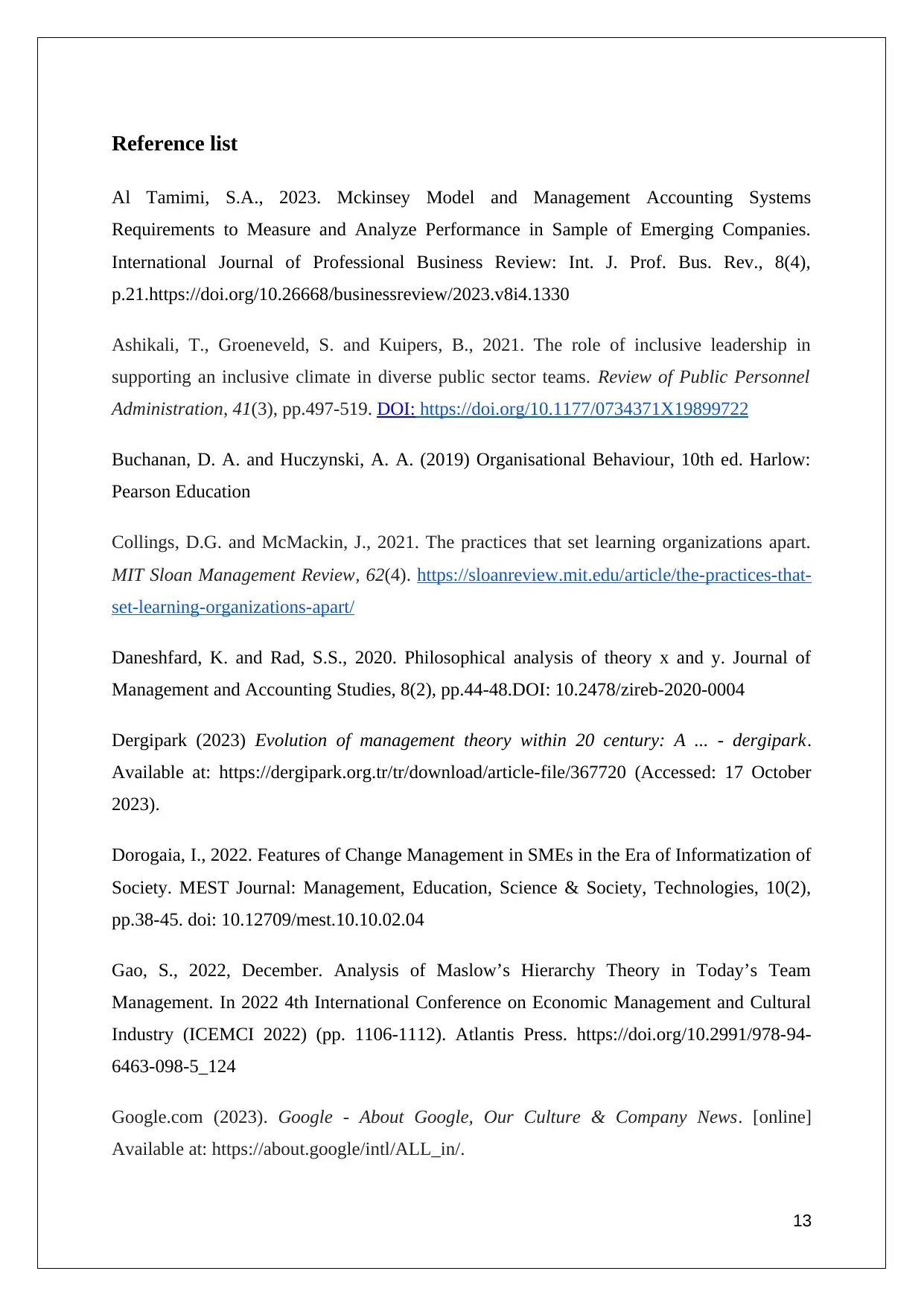
Reference list
Al Tamimi, S.A., 2023. Mckinsey Model and Management Accounting Systems
Requirements to Measure and Analyze Performance in Sample of Emerging Companies.
International Journal of Professional Business Review: Int. J. Prof. Bus. Rev., 8(4),
p.21.https://doi.org/10.26668/businessreview/2023.v8i4.1330
Ashikali, T., Groeneveld, S. and Kuipers, B., 2021. The role of inclusive leadership in
supporting an inclusive climate in diverse public sector teams. Review of Public Personnel
Administration, 41(3), pp.497-519. DOI: https://doi.org/10.1177/0734371X19899722
Buchanan, D. A. and Huczynski, A. A. (2019) Organisational Behaviour, 10th ed. Harlow:
Pearson Education
Collings, D.G. and McMackin, J., 2021. The practices that set learning organizations apart.
MIT Sloan Management Review, 62(4). https://sloanreview.mit.edu/article/the-practices-that-
set-learning-organizations-apart/
Daneshfard, K. and Rad, S.S., 2020. Philosophical analysis of theory x and y. Journal of
Management and Accounting Studies, 8(2), pp.44-48.DOI: 10.2478/zireb-2020-0004
Dergipark (2023) Evolution of management theory within 20 century: A ... - dergipark.
Available at: https://dergipark.org.tr/tr/download/article-file/367720 (Accessed: 17 October
2023).
Dorogaia, I., 2022. Features of Change Management in SMEs in the Era of Informatization of
Society. MEST Journal: Management, Education, Science & Society, Technologies, 10(2),
pp.38-45. doi: 10.12709/mest.10.10.02.04
Gao, S., 2022, December. Analysis of Maslow’s Hierarchy Theory in Today’s Team
Management. In 2022 4th International Conference on Economic Management and Cultural
Industry (ICEMCI 2022) (pp. 1106-1112). Atlantis Press. https://doi.org/10.2991/978-94-
6463-098-5_124
Google.com (2023). Google - About Google, Our Culture & Company News. [online]
Available at: https://about.google/intl/ALL_in/.
13
Al Tamimi, S.A., 2023. Mckinsey Model and Management Accounting Systems
Requirements to Measure and Analyze Performance in Sample of Emerging Companies.
International Journal of Professional Business Review: Int. J. Prof. Bus. Rev., 8(4),
p.21.https://doi.org/10.26668/businessreview/2023.v8i4.1330
Ashikali, T., Groeneveld, S. and Kuipers, B., 2021. The role of inclusive leadership in
supporting an inclusive climate in diverse public sector teams. Review of Public Personnel
Administration, 41(3), pp.497-519. DOI: https://doi.org/10.1177/0734371X19899722
Buchanan, D. A. and Huczynski, A. A. (2019) Organisational Behaviour, 10th ed. Harlow:
Pearson Education
Collings, D.G. and McMackin, J., 2021. The practices that set learning organizations apart.
MIT Sloan Management Review, 62(4). https://sloanreview.mit.edu/article/the-practices-that-
set-learning-organizations-apart/
Daneshfard, K. and Rad, S.S., 2020. Philosophical analysis of theory x and y. Journal of
Management and Accounting Studies, 8(2), pp.44-48.DOI: 10.2478/zireb-2020-0004
Dergipark (2023) Evolution of management theory within 20 century: A ... - dergipark.
Available at: https://dergipark.org.tr/tr/download/article-file/367720 (Accessed: 17 October
2023).
Dorogaia, I., 2022. Features of Change Management in SMEs in the Era of Informatization of
Society. MEST Journal: Management, Education, Science & Society, Technologies, 10(2),
pp.38-45. doi: 10.12709/mest.10.10.02.04
Gao, S., 2022, December. Analysis of Maslow’s Hierarchy Theory in Today’s Team
Management. In 2022 4th International Conference on Economic Management and Cultural
Industry (ICEMCI 2022) (pp. 1106-1112). Atlantis Press. https://doi.org/10.2991/978-94-
6463-098-5_124
Google.com (2023). Google - About Google, Our Culture & Company News. [online]
Available at: https://about.google/intl/ALL_in/.
13
Paraphrase This Document
Need a fresh take? Get an instant paraphrase of this document with our AI Paraphraser
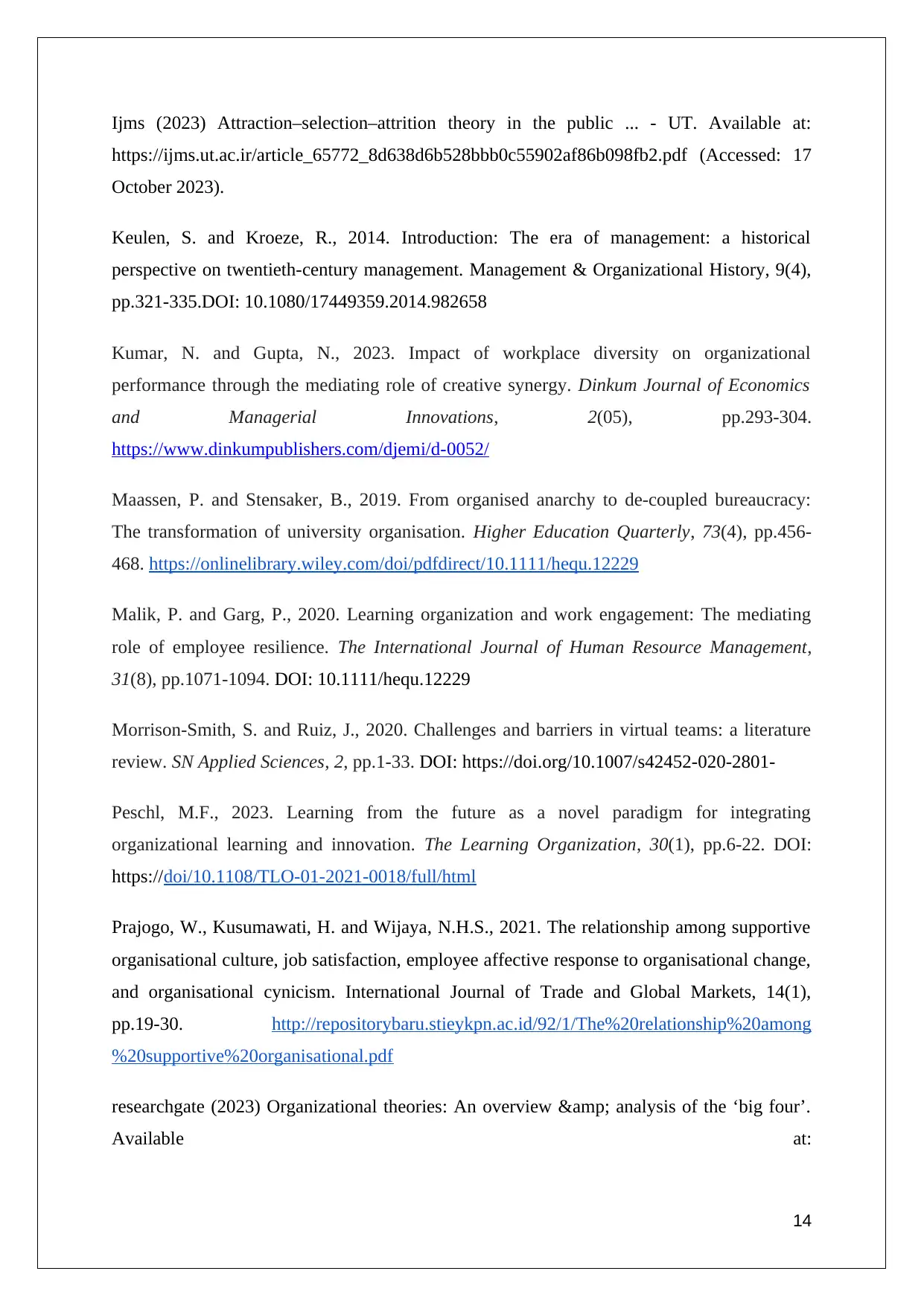
Ijms (2023) Attraction–selection–attrition theory in the public ... - UT. Available at:
https://ijms.ut.ac.ir/article_65772_8d638d6b528bbb0c55902af86b098fb2.pdf (Accessed: 17
October 2023).
Keulen, S. and Kroeze, R., 2014. Introduction: The era of management: a historical
perspective on twentieth-century management. Management & Organizational History, 9(4),
pp.321-335.DOI: 10.1080/17449359.2014.982658
Kumar, N. and Gupta, N., 2023. Impact of workplace diversity on organizational
performance through the mediating role of creative synergy. Dinkum Journal of Economics
and Managerial Innovations, 2(05), pp.293-304.
https://www.dinkumpublishers.com/djemi/d-0052/
Maassen, P. and Stensaker, B., 2019. From organised anarchy to de‐coupled bureaucracy:
The transformation of university organisation. Higher Education Quarterly, 73(4), pp.456-
468. https://onlinelibrary.wiley.com/doi/pdfdirect/10.1111/hequ.12229
Malik, P. and Garg, P., 2020. Learning organization and work engagement: The mediating
role of employee resilience. The International Journal of Human Resource Management,
31(8), pp.1071-1094. DOI: 10.1111/hequ.12229
Morrison-Smith, S. and Ruiz, J., 2020. Challenges and barriers in virtual teams: a literature
review. SN Applied Sciences, 2, pp.1-33. DOI: https://doi.org/10.1007/s42452-020-2801-
Peschl, M.F., 2023. Learning from the future as a novel paradigm for integrating
organizational learning and innovation. The Learning Organization, 30(1), pp.6-22. DOI:
https://doi/10.1108/TLO-01-2021-0018/full/html
Prajogo, W., Kusumawati, H. and Wijaya, N.H.S., 2021. The relationship among supportive
organisational culture, job satisfaction, employee affective response to organisational change,
and organisational cynicism. International Journal of Trade and Global Markets, 14(1),
pp.19-30. http://repositorybaru.stieykpn.ac.id/92/1/The%20relationship%20among
%20supportive%20organisational.pdf
researchgate (2023) Organizational theories: An overview & analysis of the ‘big four’.
Available at:
14
https://ijms.ut.ac.ir/article_65772_8d638d6b528bbb0c55902af86b098fb2.pdf (Accessed: 17
October 2023).
Keulen, S. and Kroeze, R., 2014. Introduction: The era of management: a historical
perspective on twentieth-century management. Management & Organizational History, 9(4),
pp.321-335.DOI: 10.1080/17449359.2014.982658
Kumar, N. and Gupta, N., 2023. Impact of workplace diversity on organizational
performance through the mediating role of creative synergy. Dinkum Journal of Economics
and Managerial Innovations, 2(05), pp.293-304.
https://www.dinkumpublishers.com/djemi/d-0052/
Maassen, P. and Stensaker, B., 2019. From organised anarchy to de‐coupled bureaucracy:
The transformation of university organisation. Higher Education Quarterly, 73(4), pp.456-
468. https://onlinelibrary.wiley.com/doi/pdfdirect/10.1111/hequ.12229
Malik, P. and Garg, P., 2020. Learning organization and work engagement: The mediating
role of employee resilience. The International Journal of Human Resource Management,
31(8), pp.1071-1094. DOI: 10.1111/hequ.12229
Morrison-Smith, S. and Ruiz, J., 2020. Challenges and barriers in virtual teams: a literature
review. SN Applied Sciences, 2, pp.1-33. DOI: https://doi.org/10.1007/s42452-020-2801-
Peschl, M.F., 2023. Learning from the future as a novel paradigm for integrating
organizational learning and innovation. The Learning Organization, 30(1), pp.6-22. DOI:
https://doi/10.1108/TLO-01-2021-0018/full/html
Prajogo, W., Kusumawati, H. and Wijaya, N.H.S., 2021. The relationship among supportive
organisational culture, job satisfaction, employee affective response to organisational change,
and organisational cynicism. International Journal of Trade and Global Markets, 14(1),
pp.19-30. http://repositorybaru.stieykpn.ac.id/92/1/The%20relationship%20among
%20supportive%20organisational.pdf
researchgate (2023) Organizational theories: An overview & analysis of the ‘big four’.
Available at:
14
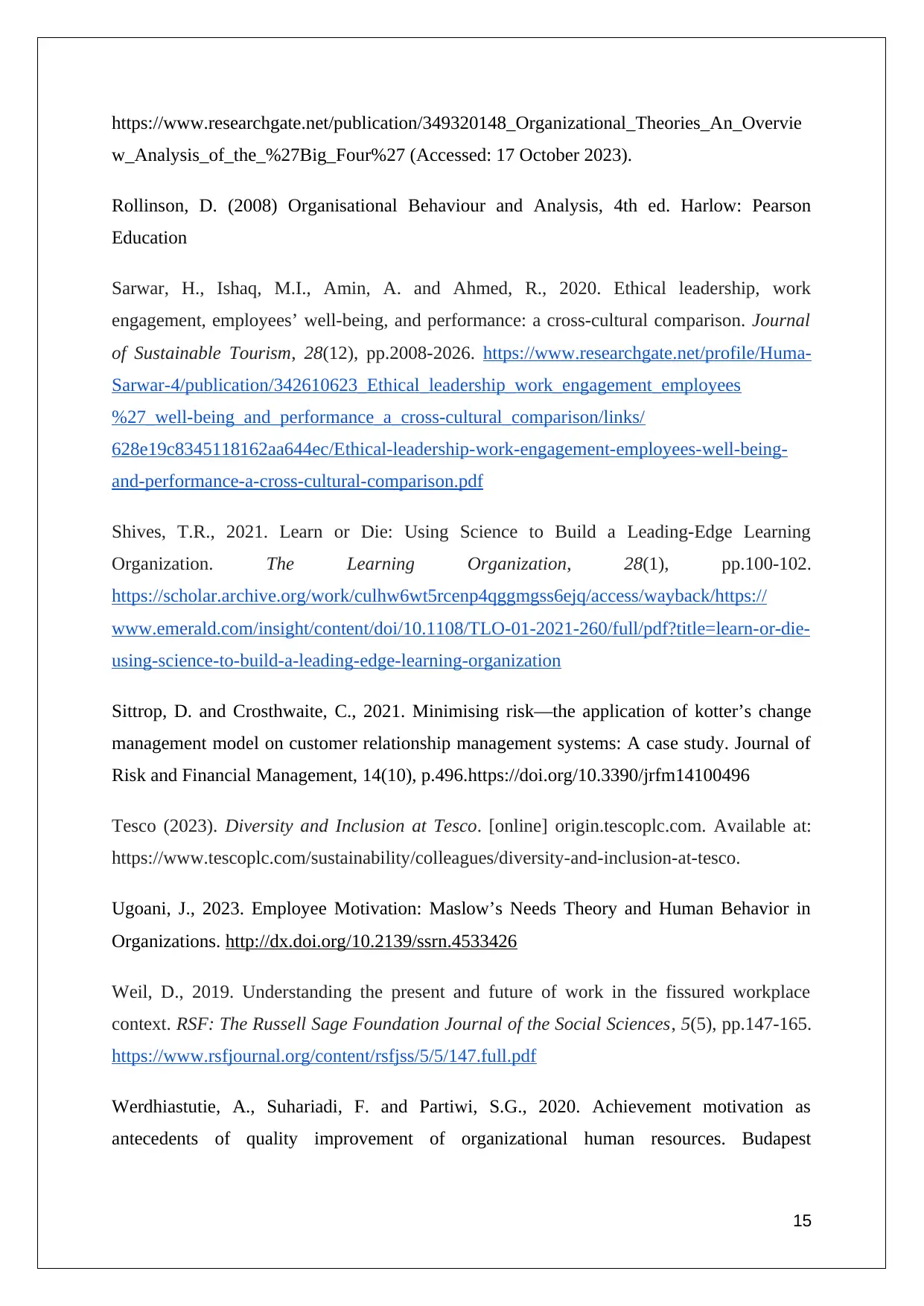
https://www.researchgate.net/publication/349320148_Organizational_Theories_An_Overvie
w_Analysis_of_the_%27Big_Four%27 (Accessed: 17 October 2023).
Rollinson, D. (2008) Organisational Behaviour and Analysis, 4th ed. Harlow: Pearson
Education
Sarwar, H., Ishaq, M.I., Amin, A. and Ahmed, R., 2020. Ethical leadership, work
engagement, employees’ well-being, and performance: a cross-cultural comparison. Journal
of Sustainable Tourism, 28(12), pp.2008-2026. https://www.researchgate.net/profile/Huma-
Sarwar-4/publication/342610623_Ethical_leadership_work_engagement_employees
%27_well-being_and_performance_a_cross-cultural_comparison/links/
628e19c8345118162aa644ec/Ethical-leadership-work-engagement-employees-well-being-
and-performance-a-cross-cultural-comparison.pdf
Shives, T.R., 2021. Learn or Die: Using Science to Build a Leading-Edge Learning
Organization. The Learning Organization, 28(1), pp.100-102.
https://scholar.archive.org/work/culhw6wt5rcenp4qggmgss6ejq/access/wayback/https://
www.emerald.com/insight/content/doi/10.1108/TLO-01-2021-260/full/pdf?title=learn-or-die-
using-science-to-build-a-leading-edge-learning-organization
Sittrop, D. and Crosthwaite, C., 2021. Minimising risk—the application of kotter’s change
management model on customer relationship management systems: A case study. Journal of
Risk and Financial Management, 14(10), p.496.https://doi.org/10.3390/jrfm14100496
Tesco (2023). Diversity and Inclusion at Tesco. [online] origin.tescoplc.com. Available at:
https://www.tescoplc.com/sustainability/colleagues/diversity-and-inclusion-at-tesco.
Ugoani, J., 2023. Employee Motivation: Maslow’s Needs Theory and Human Behavior in
Organizations. http://dx.doi.org/10.2139/ssrn.4533426
Weil, D., 2019. Understanding the present and future of work in the fissured workplace
context. RSF: The Russell Sage Foundation Journal of the Social Sciences, 5(5), pp.147-165.
https://www.rsfjournal.org/content/rsfjss/5/5/147.full.pdf
Werdhiastutie, A., Suhariadi, F. and Partiwi, S.G., 2020. Achievement motivation as
antecedents of quality improvement of organizational human resources. Budapest
15
w_Analysis_of_the_%27Big_Four%27 (Accessed: 17 October 2023).
Rollinson, D. (2008) Organisational Behaviour and Analysis, 4th ed. Harlow: Pearson
Education
Sarwar, H., Ishaq, M.I., Amin, A. and Ahmed, R., 2020. Ethical leadership, work
engagement, employees’ well-being, and performance: a cross-cultural comparison. Journal
of Sustainable Tourism, 28(12), pp.2008-2026. https://www.researchgate.net/profile/Huma-
Sarwar-4/publication/342610623_Ethical_leadership_work_engagement_employees
%27_well-being_and_performance_a_cross-cultural_comparison/links/
628e19c8345118162aa644ec/Ethical-leadership-work-engagement-employees-well-being-
and-performance-a-cross-cultural-comparison.pdf
Shives, T.R., 2021. Learn or Die: Using Science to Build a Leading-Edge Learning
Organization. The Learning Organization, 28(1), pp.100-102.
https://scholar.archive.org/work/culhw6wt5rcenp4qggmgss6ejq/access/wayback/https://
www.emerald.com/insight/content/doi/10.1108/TLO-01-2021-260/full/pdf?title=learn-or-die-
using-science-to-build-a-leading-edge-learning-organization
Sittrop, D. and Crosthwaite, C., 2021. Minimising risk—the application of kotter’s change
management model on customer relationship management systems: A case study. Journal of
Risk and Financial Management, 14(10), p.496.https://doi.org/10.3390/jrfm14100496
Tesco (2023). Diversity and Inclusion at Tesco. [online] origin.tescoplc.com. Available at:
https://www.tescoplc.com/sustainability/colleagues/diversity-and-inclusion-at-tesco.
Ugoani, J., 2023. Employee Motivation: Maslow’s Needs Theory and Human Behavior in
Organizations. http://dx.doi.org/10.2139/ssrn.4533426
Weil, D., 2019. Understanding the present and future of work in the fissured workplace
context. RSF: The Russell Sage Foundation Journal of the Social Sciences, 5(5), pp.147-165.
https://www.rsfjournal.org/content/rsfjss/5/5/147.full.pdf
Werdhiastutie, A., Suhariadi, F. and Partiwi, S.G., 2020. Achievement motivation as
antecedents of quality improvement of organizational human resources. Budapest
15
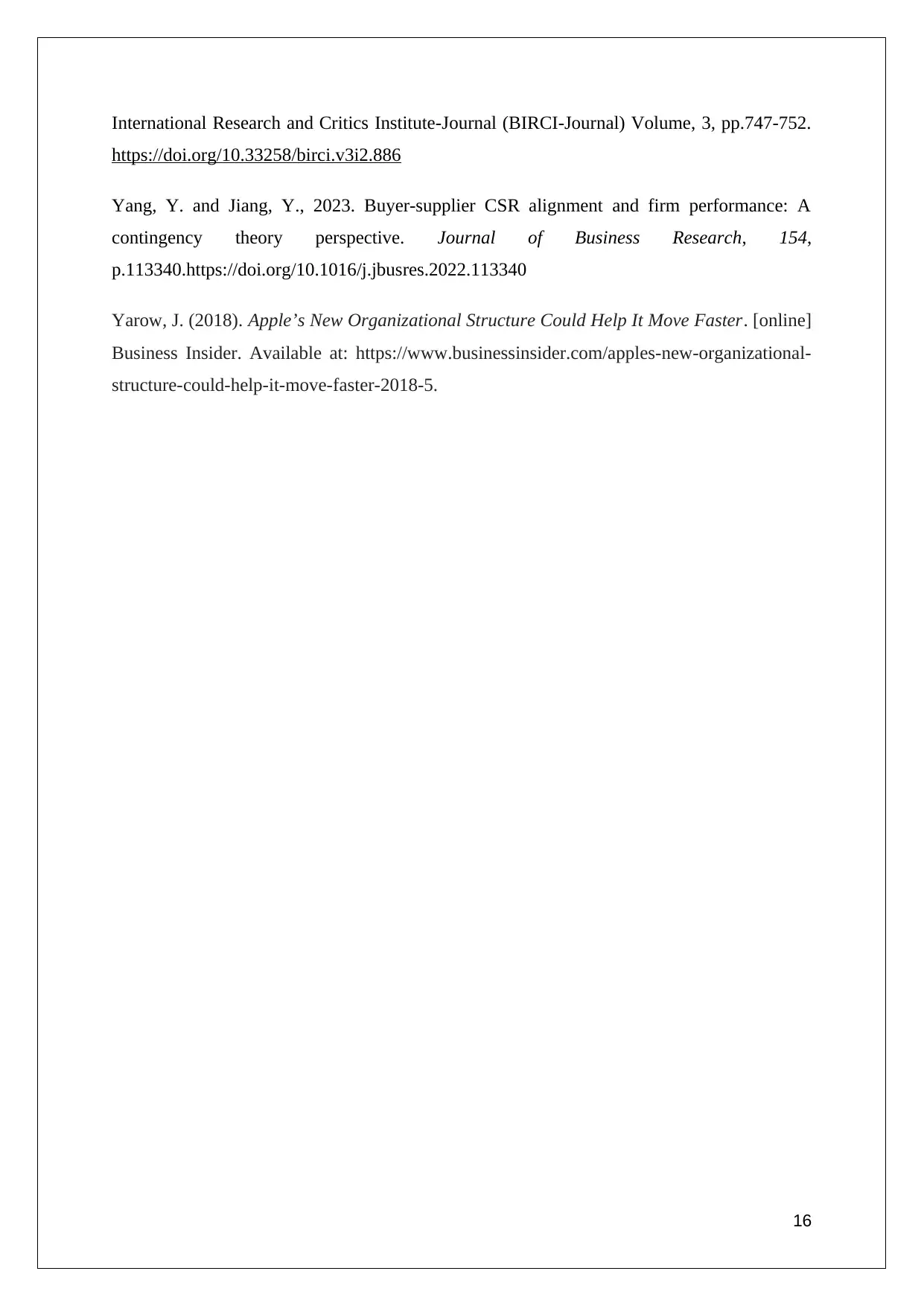
International Research and Critics Institute-Journal (BIRCI-Journal) Volume, 3, pp.747-752.
https://doi.org/10.33258/birci.v3i2.886
Yang, Y. and Jiang, Y., 2023. Buyer-supplier CSR alignment and firm performance: A
contingency theory perspective. Journal of Business Research, 154,
p.113340.https://doi.org/10.1016/j.jbusres.2022.113340
Yarow, J. (2018). Apple’s New Organizational Structure Could Help It Move Faster. [online]
Business Insider. Available at: https://www.businessinsider.com/apples-new-organizational-
structure-could-help-it-move-faster-2018-5.
16
https://doi.org/10.33258/birci.v3i2.886
Yang, Y. and Jiang, Y., 2023. Buyer-supplier CSR alignment and firm performance: A
contingency theory perspective. Journal of Business Research, 154,
p.113340.https://doi.org/10.1016/j.jbusres.2022.113340
Yarow, J. (2018). Apple’s New Organizational Structure Could Help It Move Faster. [online]
Business Insider. Available at: https://www.businessinsider.com/apples-new-organizational-
structure-could-help-it-move-faster-2018-5.
16
1 out of 16
Related Documents
Your All-in-One AI-Powered Toolkit for Academic Success.
+13062052269
info@desklib.com
Available 24*7 on WhatsApp / Email
![[object Object]](/_next/static/media/star-bottom.7253800d.svg)
Unlock your academic potential
© 2024 | Zucol Services PVT LTD | All rights reserved.





